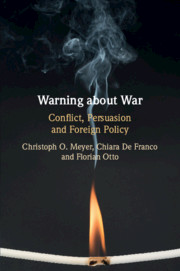Book contents
- Warning about War
- Warning about War
- Copyright page
- Contents
- Figures
- Tables
- Acknowledgements
- Chapter 1 Conflict Warnings as Persuasion Attempts
- Chapter 2 A Theory of Conflict Warning as Persuasion in Foreign Policy
- Chapter 3 Inside-Up Warnings within States and International Organisations
- Chapter 4 Outside-In Warnings
- Chapter 5 Outside-In Warnings
- Chapter 6 (Mis-)identifying Warnings and the Problem of Hindsight Bias
- Chapter 7 What Makes Individual Officials Persuasive Warners?
- Chapter 8 Explaining Differences in Persuasiveness
- Chapter 9 Warning within EU Institutions and the Ukrainian-Russian Conflict of 2013–2014
- Chapter 10 When Are Warnings Heeded and What Can Warners Do?
- References
- Index
Chapter 1 - Conflict Warnings as Persuasion Attempts
Published online by Cambridge University Press: 23 August 2019
- Warning about War
- Warning about War
- Copyright page
- Contents
- Figures
- Tables
- Acknowledgements
- Chapter 1 Conflict Warnings as Persuasion Attempts
- Chapter 2 A Theory of Conflict Warning as Persuasion in Foreign Policy
- Chapter 3 Inside-Up Warnings within States and International Organisations
- Chapter 4 Outside-In Warnings
- Chapter 5 Outside-In Warnings
- Chapter 6 (Mis-)identifying Warnings and the Problem of Hindsight Bias
- Chapter 7 What Makes Individual Officials Persuasive Warners?
- Chapter 8 Explaining Differences in Persuasiveness
- Chapter 9 Warning within EU Institutions and the Ukrainian-Russian Conflict of 2013–2014
- Chapter 10 When Are Warnings Heeded and What Can Warners Do?
- References
- Index
Summary
The chapter introduces the research puzzle of the study: under what conditions do warnings about impending violent conflict in other states succeed in persuading foreign policy-makers to pay more attention, shift their attitudes and mobilise for preventive or mitigating action? Why are some warnings by some sources noticed and largely accepted, while others are ignored, disbelieved or simply not acted upon? The introduction reviews briefly the literature on the warning–response gap in intelligence and peace studies and makes the case for recasting the problem as one of persuasion. It defines and conceptualises what warnings are, their different claims and varied impact. It argues that only by explaining differences in persuasiveness can prospective warners learn the right lessons. To tackle the questions, the chapter introduces the comparative and longitudinal research design, the methods used and data gathered. The chapter concludes by outlining briefly the structure of the book.
- Type
- Chapter
- Information
- Warning about WarConflict, Persuasion and Foreign Policy, pp. 1 - 19Publisher: Cambridge University PressPrint publication year: 2019

